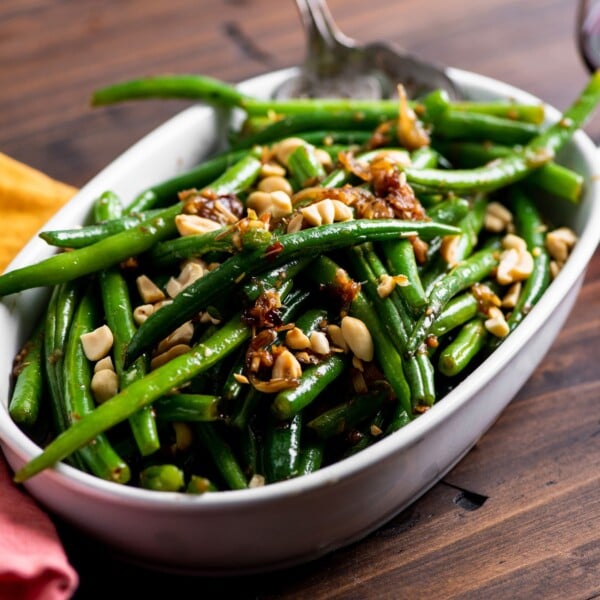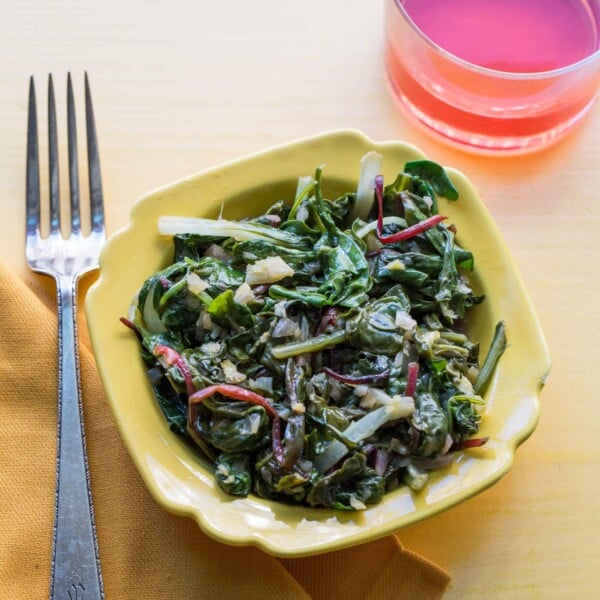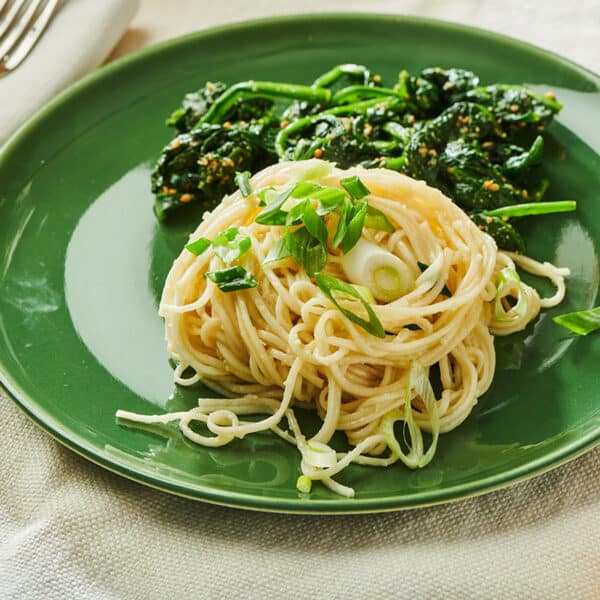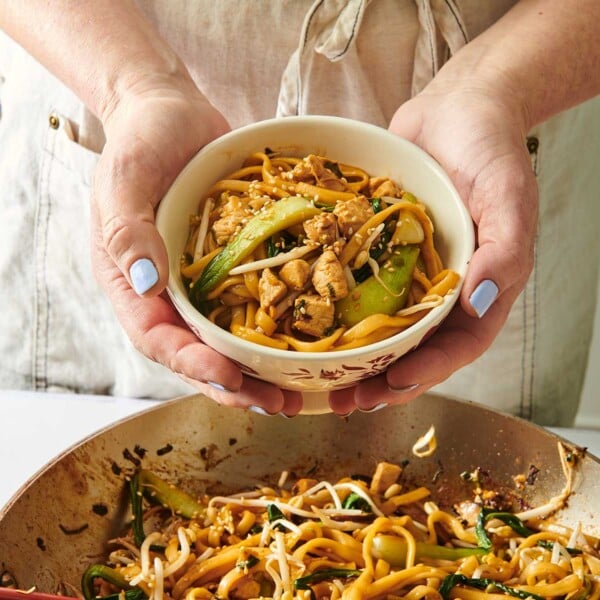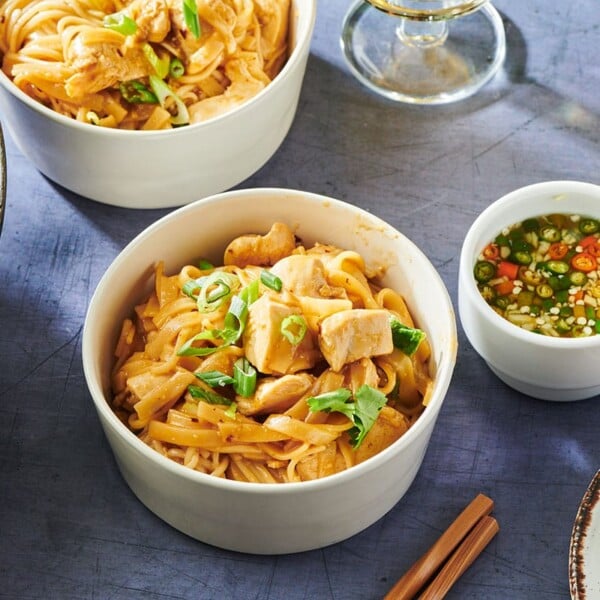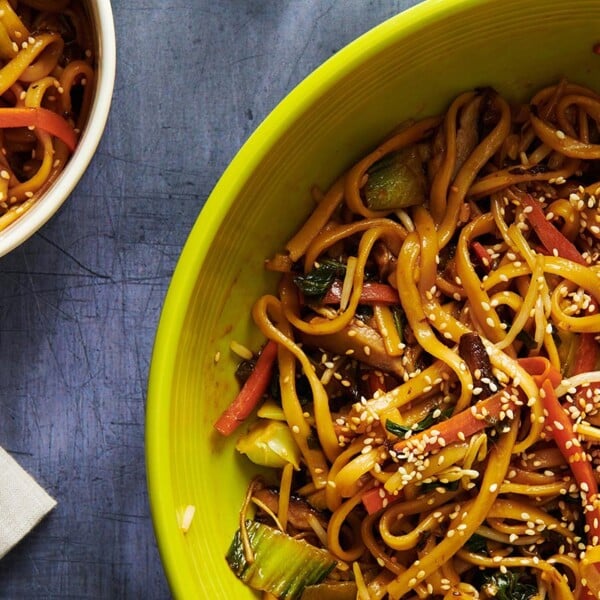Drunken Noodles (Pad Kee Mao)
on Sep 05, 2021, Updated Apr 17, 2025
This post may contain affiliate links. Please read our disclosure policy.
This popular Thai dish features satisfyingly chewy and tender rice noodles tossed with a pungent, addicting sauce.
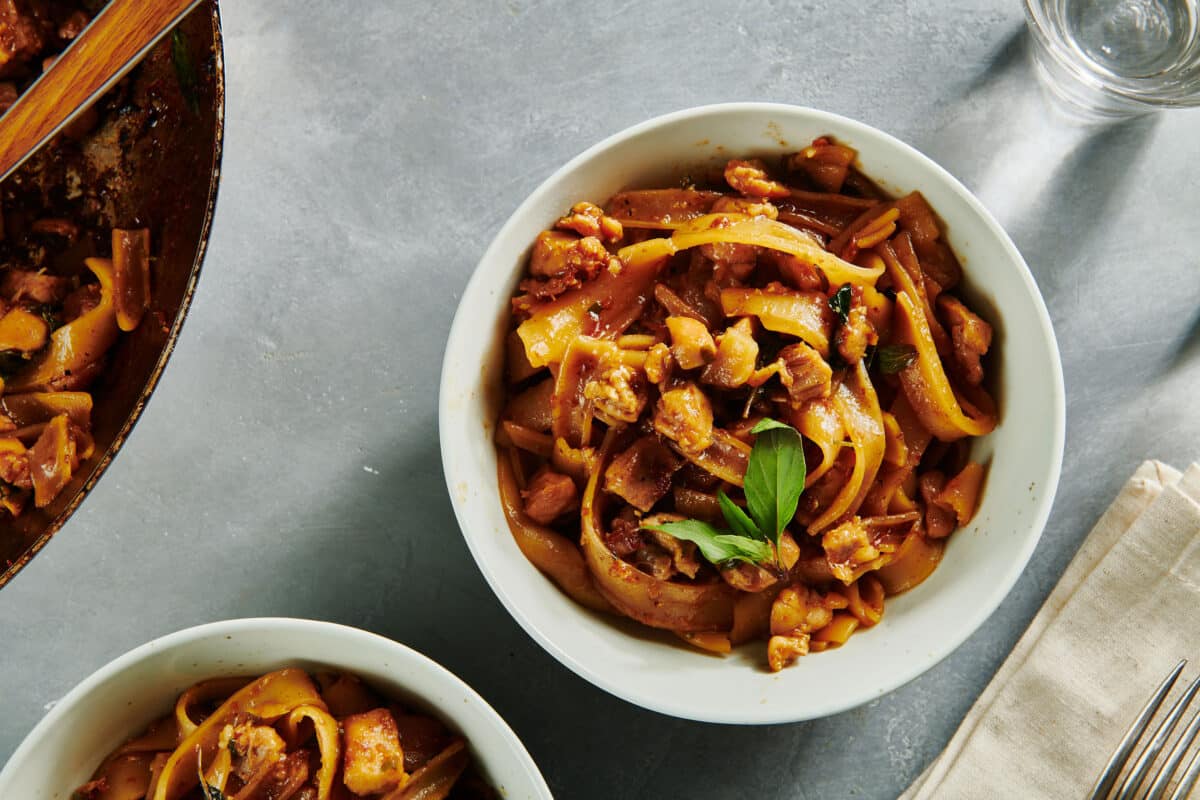
Drunken noodles are a popular Thai dish, also known as Pad Kee Mao, phat khii mao, and sometimes pad ki mao or pad kimao. The name of the dish means “drunkard,” and it evolved as a dish that was often pulled together (and still is!) from ingredients commonly found in a Thai kitchen, as an antidote to a night of drinking.
Full of flavor, satiating because of the rice noodles, and quick and easy to pull together. It’s hangover food to be sure, but also fabulous even when you haven’t been overindulging. Often this dish is made with pork, but in this drunken noodles recipe, I used chicken.
By signing up, you agree to our Privacy Policy.
Serve Pad Kee Mao with Thai Cucumber Salad, Braised Asian Baby Bok Choy, or your favorite Asian side.
What's In This Post?

Drunken Noodles Sauce
The sauce for this dish is usually a combination of soy sauce, a bit of sugar, something spicy (in this case, red pepper flakes), fish sauce, garlic, and, for this recipe, a bit of minced fresh ginger. Fresh basil is also an ingredient in this dish, and you should make every effort to find Thai basil, which has a sharp kick to it and absolutely makes the dish. Holy basil is another choice. As a last resort, Italian basil can be used, but purists will shrug their shoulders a bit at that.
I often use less-sodium soy sauce in my Asian cooking to keep the salt levels in check, but that salty pop is what makes the dish needs to bring it on home. If you want the real experience, you can use other types of dark and salty soy sauces. I’ve also included some oyster sauce in my take on Pad Kee Mao.
Diced chicken is also a common ingredient in this Thai stir-fry, and you can decide between boneless, skinless chicken thighs or breasts as you prefer. You can also add the vegetables of your choice to bump up the nutrition and texture.

Ingredients
- Wide rice noodles – In Thailand or in some restaurants, you might find this dish made with fresh noodles, but at home, it’s usually made with dried rice noodles, which have a long shelf life and are a pantry staple. The noodles might be labeled Pad Thai noodles; get the widest ones you can, but don’t worry about it — any flat rice noodles will work.
- Soy sauce – Again, preferably less-sodium soy sauce.
- Canola Oil
- Cornstarch – Often used in Asian dishes to thicken the sauce.
- Chicken – Choose between boneless, skinless breasts or thighs, and cut them into 1/2-inch pieces.
- Chicken broth – The less-sodium broth keeps the dish’s saltiness in check.
- Brown sugar – A touch of sweetness adds balance to the overall flavor.
- Oyster sauce
- Mirin – This sweetened Japanese rice wine is optional, and you can use dry sherry if that’s what you have.
- Red pepper flakes – For a bit of heat.
- Minced garlic
- Fish sauce – This is available at well-stocked markets and Asian grocery stores, as well as online.
- Scallions or green onions
- Thai basil leaves – You might see this called Thai basil, or Thai holy basil. Regular basil will also work in a pinch.
- Chili oil – For serving, but optional.
How to Make Drunken Noodles
- Prepare the noodles: Soften the rice noodles according to the package directions (learn about cooking rice noodles here).
- Marinate the chicken: In a large bowl, mix 1 tablespoon soy sauce, 1 tablespoon of the oil, 1 tablespoon water, and the cornstarch, then add the chicken and toss. Let sit for 20 minutes.

- Make the sauce: Meanwhile, in a small bowl or container, mix together the chicken broth, 1/3 cup soy sauce, 1 tablespoon of the oil, brown sugar, oyster sauce, mirin, red pepper flakes, 1 tablespoon garlic, fish sauce, and salt and pepper. Set aside.
- Stir-fry the chicken: Heat 1 1/2 teaspoons of the remaining oil in a very large skillet or a wok over medium-high heat. Add half the chicken and stir fry until it’s almost cooked through, about 3 minutes for breast meat and 4 or 5 minutes for thigh meat. Remove the chicken to a plate, and repeat with another 1 1/2 teaspoons of the oil and the rest of the chicken. Return the first batch of chicken to the pan.

- Add the 4 sliced scallions, the remaining tablespoon of garlic, and the ginger, and sauté for 30 seconds until you can smell the garlic.
- Restir the sauce and add it to the pan with the drained, soaked noodles and half of the basil. Toss and cook for about 2 minutes until the chicken is cooked through and the sauce has thickened and coats everything nicely.

- Sprinkle over the remaining basil leaves and serve from the pan or transfer the noodles to a serving dish. Serve hot with chili oil if desired.
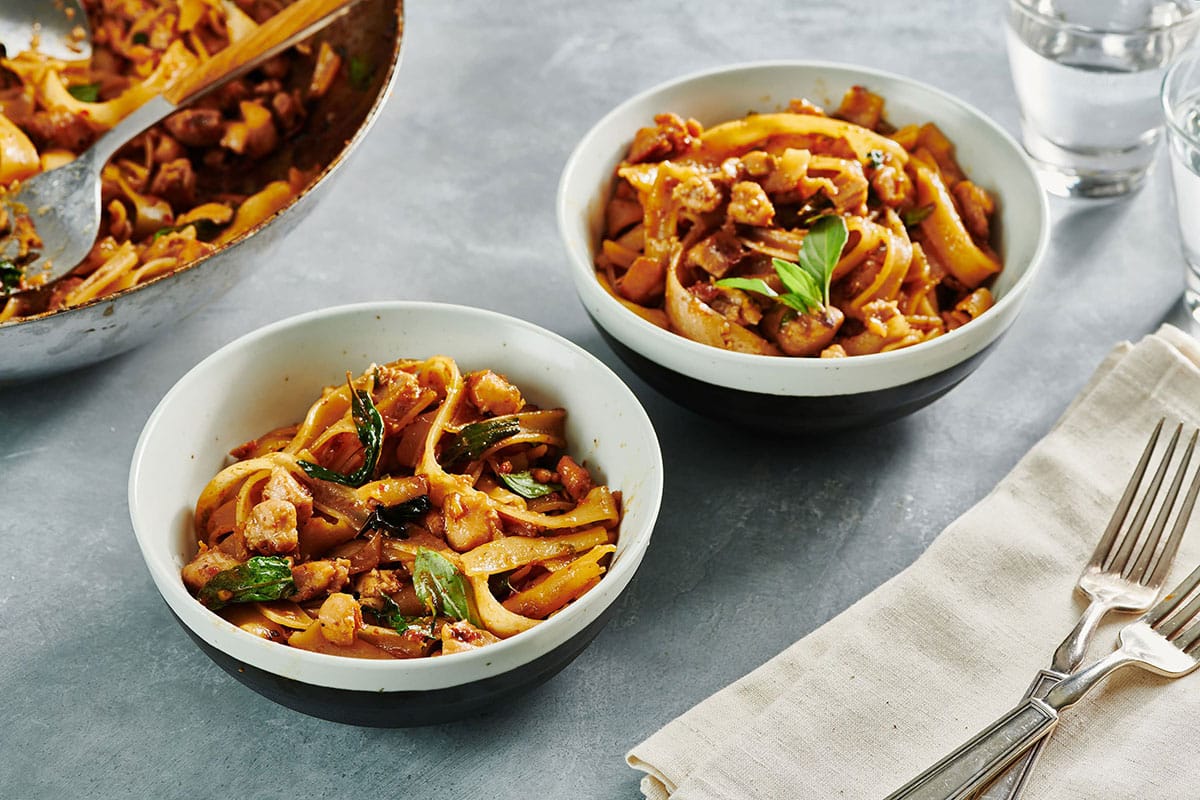
Variations
- You can use pork or beef instead of the chicken.
- Also, try cubed tofu (perhaps crispy tofu) for even more texture. This could even become a vegetarian dish if you replace the chicken with tofu and switch out a couple ingredients: vegan oyster sauce is available and it’s easy to make a vegan fish sauce substitute.
- Add some chopped broccoli to the dish when you sauté the chicken.
- Toss in some drained baby corn at the end when you are finishing cooking the chicken through.
Storage
Leftovers will keep for about 5 days in an airtight container in the fridge. They are great cold, or heat them up in the microwave or in a skillet or wok.
What to Serve With Drunken Noodles

More Asian Noodle Recipes
- A favorite restaurant dish, it’s surprisingly easy to make Pad Thai at home.
- And, if you skip the shrimp and switch to vegan “fish sauce,” a delicious Vegetarian Pad Thai awaits.
- Asian Stir-Fried Shrimp and Rice Noodles is similar to Pad Thai, and makes a quick weeknight dinner.
- With just 15 minutes of time, this Noodles with Peanut Sauce recipe comes together with pantry ingredients.
- Yaki Udon is a slurpable bowl of noodles that will become a staple in your recipe repertoire.
Pin this now to find it later
Pin It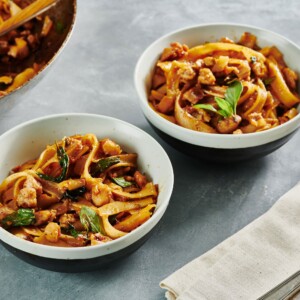
Drunken Noodles (Pad Kee Mao)
Ingredients
- 12 ounces dried wide rice noodles
- ⅓ cup plus 1 tablespoon less-sodium soy sauce (divided)
- 4 tablespoons canola oil (divided)
- 1 tablespoon cornstarch
- 1 ½ pounds boneless skinless chicken breasts or thighs (cut into 1/2-inch dice)
- ½ cup less-sodium chicken broth
- 2 tablespoons brown sugar (light or dark brown)
- 3 tablespoons oyster sauce
- 2 tablespoon mirin (Japanese sweetened rice wine; optional; you can also use dry sherry)
- ¼ teaspoon red pepper flakes
- 2 tablespoons minced garlic (divided)
- 1 tablespoon fish sauce
- Kosher salt and freshly ground black pepper (to taste)
- 4 scallions (white and green parts, thinly sliced on the diagonal, plus more for garnish)
- 2 tablespoons minced fresh ginger
- 1 cup small leaf or roughly chopped Holy basil (Thai basil, or in a pinch regular basil)
- Chili oil (to serve; optional)
Instructions
- Soften the rice noodles according to package directions. If there are no directions, place the noodles in a large bowl and add hot water to cover. Allow them to soak for 15 minutes until softened but not mushy, then drain and set aside.
- In a large bowl, mix 1 tablespoon soy sauce, 1 tablespoon of the oil, 1 tablespoon water, and the cornstarch, then add the chicken and toss. Let sit for 20 minutes.
- Make the sauce: Meanwhile, in a small bowl or container, mix together the chicken broth, 1/3 cup soy sauce, 1 tablespoon of the oil, brown sugar, oyster sauce, mirin, red pepper flakes, 1 tablespoon garlic, fish sauce, and salt and pepper. Set aside.
- Heat 1 1/2 teaspoons of the remaining oil in a very large skillet or a wok over medium-high heat. Add the half the chicken and stir fry until it’s almost cooked through, about 3 minutes for breast meat, 4 or 5 minutes for thigh meat. Remove the chicken to a plate, and repeat with another 1 1/2 teaspoons of the oil and the rest of the chicken. Return the first batch of chicken to the pan. Add the 4 sliced scallions, the remaining tablespoon of garlic, and the ginger, and sauté for 30 seconds until you can smell the garlic.
- Restir the sauce and add it to the pan with the drained, soaked noodles and half of the basil. Toss and cook for about 2 minutes until the chicken is cooked through and the sauce has thickened and coats everything nicely.
- Sprinkle over the remaining basil leaves and serve from the pan or transfer the noodles to a serving dish. Serve hot with chili oil if desired.
